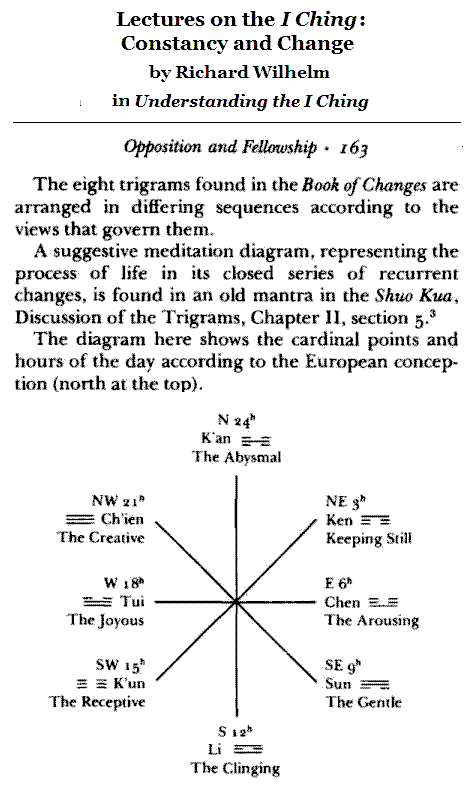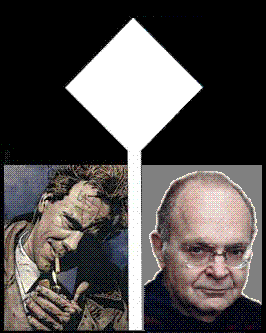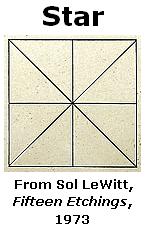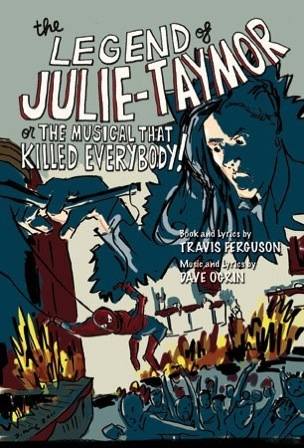For some commentary,
see Spider in this journal.
Monday, December 12, 2016
Tuesday, August 23, 2016
Web Day
Today is said to be the 25th anniversary of the
opening to the public of the World Wide Web.
Related material: Click on the above icon for
posts mentioning "Spider Woman."
Wednesday, July 13, 2016
Friday, August 24, 2012
Thursday, August 23, 2012
Chapman’s Homer
Louis Sahagun in today's Los Angeles Times—
The late Professor Marvin W. Meyer
"was our Indiana Jones," said James L. Doti,
president of Chapman University in Orange,
where Meyer held the Griset Chair in Bible
and Christian Studies and was director of
the Albert Schweitzer Institute.
Meyer reportedly died on August 16.
Thursday, August 16, 2012
|
Thursday, August 16, 2012
Semiotics
"Two clichés make us laugh, but
a hundred clichés move us
because we sense dimly that the clichés
are talking among themselves and
celebrating a reunion."
"'Casablanca': Cult Movies and Intertextual Collage,"
by Umberto Eco in SubStance , Vol. 14, No. 2, Issue 47:
In Search of Eco's Roses (1985), pp. 3-12.
(This paper was presented at a symposium,
"Semiotics of the Cinema: The State of the Art,"
in Toronto on June 18, 1984.)
Journal article published by U. of Wisconsin Press.
Stable URL: http://www.jstor.org/stable/3685047.
Click image for some related material.
Wednesday, May 16, 2012
Midnight in Paris– The Morning After
(Continued from yesterday evening)
On Max Bialystock's Spider-Man Godspell Seminar—
"… for surrealism to be entertaining
onstage, it must be shaped into
some kind of satisfying form."
— Charles Isherwood
in today's New York Times
(RSS: Wed, 16 May 2012 00:37:17 GMT)
From Fritz Leiber's 1959 story "Damnation Morning" —
She drew from her handbag a pale grey gleaming
implement that looked by quick turns to me
like a knife, a gun, a slim sceptre, and a delicate
branding iron— especially when its tip sprouted
an eight-limbed star of silver wire.
“The test?” I faltered, staring at the thing.
“Yes, to determine whether you can live
in the fourth dimension or only die in it.”
Monday, September 12, 2011
Spider Flagship
Microsoft plans Windows 8 compatibility with mobile devices
"This won't be just another upgrade. Windows 8 is nothing less than the linchpin to Microsoft's strategy for keeping Windows relevant— if not resurgent— as the shift to the post-PC computing era unfolds.
'The stakes are huge,' says Charles King, principal analyst at research firm Pund-IT. 'The company must play outside its comfort zone, but if Microsoft succeeds, the potential opportunities could be significant.'"
— Byron Acohido in USA TODAY this evening
Yesterday's 7:20 AM Google News—

From Cliff Robertson's 1958 TV classic "Days of Wine and Roses"—

From Fritz Leiber's 1959 sci-fi classic "Damnation Morning" —
She drew from her handbag a pale grey gleaming implement
that looked by quick turns to me like a knife, a gun,
a slim sceptre, and a delicate branding iron— especially when
its tip sprouted an eight-limbed star of silver wire.
“The test?” I faltered, staring at the thing.
“Yes, to determine whether you can live in the fourth dimension or only die in it.”
Thursday, August 18, 2011
Banderas*
For Ms. Julie and the Pope
For Ms. Julie:
Nuevas Banderas in this journal…
Click on image
for details.
See also Balakrishnan's Last Problem—
For the Pope:
Now playing; click poster for details.
See also "Damnation Morning" in this journal—
She drew from her handbag a pale grey gleaming implement that looked by quick turns to me like a knife, a gun, a slim sceptre, and a delicate branding iron—especially when its tip sprouted an eight-limbed star of silver wire. “The test?” I faltered, staring at the thing. “Yes, to determine whether you can live in the fourth dimension or only die in it.” — Fritz Leiber, short story, 1959
* For a time-leap from Leiber's 1959 to Hollywood's 2011, see yesterday's
Marginal Remarks, "The God particle ?" and a different Banderas.
Friday, April 15, 2011
Spider Notes
Monday, January 31, 2011
Darkness at Noon
In today's Wall Street Journal , Peter Woit reviews a new book on dark matter and dark energy.
For a more literary approach, see "dark materials" in this journal.
Before thir eyes in sudden view appear The secrets of the hoarie deep, a dark Illimitable Ocean without bound, Without dimension, where length, breadth, and highth, And time and place are lost; where eldest Night And Chaos, Ancestors of Nature, hold Eternal Anarchie, amidst the noise Of endless warrs and by confusion stand. For hot, cold, moist, and dry, four Champions fierce Strive here for Maistrie, and to Battel bring amidst the noise Thir embryon Atoms.... ... Into this wilde Abyss, The Womb of nature and perhaps her Grave, Of neither Sea, nor Shore, nor Air, nor Fire, But all these in thir pregnant causes mixt Confus'dly, and which thus must ever fight, Unless th' Almighty Maker them ordain His dark materials to create more Worlds, Into this wilde Abyss the warie fiend Stood on the brink of Hell and look'd a while, Pondering his Voyage.... -- John Milton, Paradise Lost , Book II
Related material:
1. The “spider” symbol of Fritz Leiber’s short story “Damnation Morning”—

2. Angels and demons here and in the Catholic Church.
3. The following diagram by one “John Opsopaus”—

Friday, October 1, 2010
Sunday, January 24, 2010
Today’s Sermon
More Than Matter
| Wheel in Webster’s Revised Unabridged Dictionary, 1913
(f) Poetry The burden or refrain of a song. ⇒ “This meaning has a low degree of authority, but is supposed from the context in the few cases where the word is found.” Nares. You must sing a-down a-down, An you call him a-down-a. O, how the wheel becomes it! Shak. |
“In one or other of G. F. H. Shadbold’s two published notebooks, Beyond Narcissus and Reticences of Thersites, a short entry appears as to the likelihood of Ophelia’s enigmatic cry: ‘Oh, how the wheel becomes it!’ referring to the chorus or burden ‘a-down, a-down’ in the ballad quoted by her a moment before, the aptness she sees in the refrain.”
— First words of Anthony Powell’s novel “O, How the Wheel Becomes It!” (See Library Thing.)

Related material:
Photo uploaded on January 14, 2009
with caption “This nothing’s more than matter”
and the following nothings from this journal
on the same date– Jan. 14, 2009—
Tuesday, April 7, 2009
Tuesday April 7, 2009
|
Bright Star and Dark Lady “Mexico is a solar country — but it is also a black country, a dark country. This duality of Mexico has preoccupied me since I was a child.” — Octavio Paz, |
||
|
Bright Star
|
Amen.
|
Dark Lady
|
The same story on
May 11, 2005
with a different
dark lady:

Monday, March 16, 2009
Monday March 16, 2009
continued
Annals of Prose Style
|
“Preserving a strict unity of time and place, this stark tale of a young woman’s decline into insanity is set in a summer home on a holiday island. It is the first part of the trilogy that comprises Winter Light and The Silence, films which are generally seen as addressing Bergman’s increasing disillusionment with the emotional coldness of his inherited Lutheran religion. In particular here, Bergman focuses on the absence of familial love which might perhaps have pulled Karin (Andersson) back from the brink; while Karin’s mental disintegration manifests itself in the belief that God is a spider. As she slips inexorably into madness, she is observed with terrifying objectivity by her emotionally paralyzed father (Björnstrand) and seemingly helpless husband (von Sydow).”
Related material:
1. The “spider” symbol of Fritz Leiber’s short story “Damnation Morning”–

2. Hollywood’s “Angels & Demons” (to open May 15), and
3. The following diagram by one “John Opsopaus”–

Monday March 16, 2009
continued
Annals of Prose Style
|
“Preserving a strict unity of time and place, this stark tale of a young woman’s decline into insanity is set in a summer home on a holiday island. It is the first part of the trilogy

that comprises Winter Light and The Silence, films which are generally seen as addressing Bergman’s increasing disillusionment with the emotional coldness of his inherited Lutheran religion. In particular here, Bergman focuses on the absence of familial love which might perhaps have pulled Karin (Andersson) back from the brink; while Karin’s mental disintegration manifests itself in the belief that God is a spider. As she slips inexorably into madness, she is observed with terrifying objectivity by her emotionally paralyzed father (Björnstrand) and seemingly helpless husband (von Sydow).”
— Nigel Floyd, Time Out, quoted at Bergmanorama
Related material:
1. The “spider” symbol of Fritz Leiber’s short story “Damnation Morning“–

2. The Illuminati Diamond of Hollywood’s “Angels & Demons” (to open May 15), and
3. The following diagram by one “John Opsopaus“–
Wednesday, January 14, 2009
Thursday, October 23, 2008
Thursday October 23, 2008
|
Along Came
a Spider
A phrase from 1959
"Look, Buster, |
… Todo lo sé
por el lucero puro
que brilla en la diadema
de la Muerte.
The link to
"Buffalo Soldier"
in this entry
is in memory of
Vittorio Foa, who
died Monday
at his home
outside Rome.
Saturday, June 21, 2008
Saturday June 21, 2008
(See Eight is a Gate and
Faith, Doubt, Art, and
The New Yorker.)
A sructure from
today's previous entry:

|
Everyone comes to Rick's.
Sunday, February 17, 2008
Sunday February 17, 2008
New York Times today–
"Plot Would Thicken, if the
Writers Remembered It"
"We've lost the plot!"
— Slipstream
|
Excerpt from Fritz Leiber's Time traveling, which is not quite the good clean boyish fun it's cracked up to be, started for me when this woman with the sigil on her forehead looked in on me from the open doorway of the hotel bedroom where I'd hidden myself and the bottles and asked me, "Look, Buster, do you want to live?"…. Her right arm was raised and bent, the elbow touching the door frame, the hand brushing back the very dark bangs from her forehead to show me the sigil, as if that had a bearing on her question.
Bordered version The sigil was an eight-limbed asterisk made of fine dark lines and about as big as a silver dollar. An X superimposed on a plus sign. It looked permanent…. … "Here is how it stacks up: You've bought your way with something other than money into an organization of which I am an agent…." "It's a very big organization," she went on, as if warning me. "Call it an empire or a power if you like. So far as you are concerned, it has always existed and always will exist. It has agents everywhere, literally. Space and time are no barriers to it. Its purpose, so far as you will ever be able to know it, is to change, for its own aggrandizement, not only the present and the future, but also the past. It is a ruthlessly competitive organization and is merciless to its employees." "I. G. Farben?" I asked grabbing nervously and clumsily at humor. She didn't rebuke my flippancy, but said, "And it isn't the Communist Party or the Ku Klux Klan, or the Avenging Angels or the Black Hand, either, though its enemies give it a nastier name." "Which is?" I asked. "The Spiders," she said. That word gave me the shudders, coming so suddenly. I expected the sigil to step off her forehead and scuttle down her face and leap at me– something like that. She watched me. "You might call it the Double Cross," she suggested, "if that seems better." |
Related material:
the previous entry.
Thursday, September 21, 2006
Thursday September 21, 2006
Symbolism
continued from
Oct. 14, 2004

A related symbol, in memory of
two-time Academy Award winning
cinematographer Sven Nykvist,
who died yesterday:

(See Why Me?, Show Business,
and the cover of the DVD of
an Ingmar Bergman trilogy
photographed by Nykvist.)
Saturday, September 2, 2006
Saturday September 2, 2006
Salma Hayek
("Frida")

"Shinin' like a diamond
she had tombstones
in her eyes."

(For the above figures,
see Log24, 5/17/06,
"Tombstone," and
Log24, 9/13/03,
"For the Man in Black.")
and Keanu Reeves
("Constantine")

(For the above figure,
see Log24, 2/18/05,
"In Hoc Signo.")
Related material:
"Un cofre de gran riqueza
Hallaron dentro un pilar,
Dentro del, nuevas banderas
Con figuras de espantar."
"A coffer of great richness
In a pillar's heart they found,
Within it lay new banners,
With figures to astound."

For some further details, see
the brief Log24 narrative
"Indiana Jones and
the Hidden Coffer" as well as
Symmetry Framed and
the design of the doors
to Rick's Cafe Americain:

Saturday, February 11, 2006
Saturday February 11, 2006
From Dogma Part II: Amores Perros:
"Do Catholics believe that when you die your soul goes up in the sky? To heaven, if they go to heaven?"
— Hope of Heaven, by John O'Hara (1938), Carroll & Graf paperback, 1985, page 162
"My blue dream of being in a basket like a kite held by a rope against the wind…. It's fun to stretch and see the blue heavens spreading once more, spreading azure thighs for adventure."
— F. Scott Fitzgerald, The Last Tycoon (1941), Collier paperback, 1986, page 162
The following work of art
illustrates the above remarks.

Tuesday, November 15, 2005
Tuesday November 15, 2005

Upper part of above picture–
From today’s New York Times,
Seeing Mountains in
Starry Clouds of Creation.
Lower part of above picture–
Pilgrimage to Spider Rock:
Vine Deloria Jr.,
Evolution, Creationism,
and Other Modern Myths:
“The continuing struggle between evolutionists and creationists, a hot political topic for the past four decades, took a new turn in the summer of 1999 when the Kansas Board of Education voted to omit the mention of evolution in its newly approved curriculum, setting off outraged cries of foul by the scientific establishment. Don Quixotes on both sides mounted their chargers and went searching for windmills.”
A figure from
last night’s entry,
Spider Woman:

From Sunday, the day
of Vine Deloria’s death,
a picture that might be
called Changing Woman:


Kaleidoscope turning…
Shifting pattern
within unalterable structure…
— Roger Zelazny, Eye of Cat

in Time and Eternity
(Log 24, Feb. 1, 2003)
and
a review
of Fritz Leiber’s
The Big Time,
Tuesday November 15, 2005
“Time traveling, which is not quite the good clean boyish fun it’s cracked up to be, started for me when this woman with the sigil on her forehead looked in on me from the open doorway of the hotel bedroom where I’d hidden myself and the bottles and asked me, ‘Look, Buster, do you want to live?’….
Her right arm was raised and bent, the elbow touching the door frame, the hand brushing back the very dark bangs from her forehead to show me the sigil, as if that had a bearing on her question.

Bordered version
of the sigil
The sigil was an eight-limbed asterisk made of fine dark lines and about as big as a silver dollar. An X superimposed on a plus sign. It looked permanent.”
— Fritz Leiber, “Damnation Morning“
For Vine Deloria Jr., who died at 72 on Sunday, Nov. 13, 2005:
Things forgotten are shadows.
The shadows will be as real
as wind and rain and song and light,
there in the old place.
Spider Woman atop your rock,
I would greet you,
but I am going the other way.
Only a fool would pursue a Navajo
into the Canyon of Death.
from a Log24 entry
on the morning of
Deloria’s death–
Kaleidoscope turning…
Shifting pattern
within unalterable structure…
— Roger Zelazny, Eye of Cat
Saturday, June 25, 2005
Saturday June 25, 2005
Religious Symbolism
at Midnight:

Related material:
Star Wars 6/13/05,
Dark City 6/14/05,
and De Arco, as well
as the following from
July 26, 2003:
|
Bright Star and Dark Lady "Mexico is a solar country — but it is also a black country, a dark country. This duality of Mexico has preoccupied me since I was a child."
— Octavio Paz, |
||
|
Bright Star
|
Amen.
|
Dark Lady
|
Tuesday, May 24, 2005
Tuesday May 24, 2005
Two Poles
From today’s New York Times:

From erraticimpact.com on Paul Ricoeur:
the narratologist Algirdas-Julien Greimas.
between the philosophical and religious
domains, attempting to reconcile
the two poles in his thought.”
| From today’s NYT obituary of Sol Stetin:
“Mr. Stetin, who emigrated from Poland at the age of 10 and dropped out of high school in the ninth grade, was fond of saying he got his education in the labor movement.” |
 |
continued:
“… it is not in isolation that the rhetorical power of such oppositions resides, but in their articulation in relation to other oppositions. In Aristotle’s Physics the four elements of earth, air, fire and water were said to be opposed in pairs. For more than two thousand years oppositional patterns based on these four elements were widely accepted as the fundamental structure underlying surface reality….
 The structuralist semiotician Algirdas Greimas introduced the semiotic square (which he adapted from the ‘logical square’ of scholastic philosophy) as a means of analysing paired concepts more fully….”
The structuralist semiotician Algirdas Greimas introduced the semiotic square (which he adapted from the ‘logical square’ of scholastic philosophy) as a means of analysing paired concepts more fully….”
— Daniel Chandler, Semiotics for Beginners
Poetry’s Bones and
Theme and Variations.
Other readings on polarity:
Log24, May 24, 2003, and
from July 26, 2003:
|
Bright Star and Dark Lady “Mexico is a solar country — but it is also a black country, a dark country. This duality of Mexico has preoccupied me since I was a child.” — Octavio Paz, |
||
|
Bright Star
|
Amen. |
Dark Lady
|
Sunday, May 1, 2005
Sunday May 1, 2005
Harvard's Barry Mazur on
one mathematical style:
"It’s the barest, most Beckett-like vocabulary
that incorporates the theory and nothing else."
Samuel Beckett, Quad (1981):

A Jungian on this six-line logo:
"They are the same six lines
that exist in the I Ching….
Now observe the square more closely:
four of the lines are of equal length,
the other two are longer….
For this reason symmetry
cannot be statically produced
and a dance results."
— Marie-Louise von Franz,
Number and Time (1970),
Northwestern U. Press
paperback, 1979, p. 108
A related logo from
Columbia University's
Department of Art History
and Archaeology:

Also from that department:

Meyer Schapiro Professor
of Modern Art and Theory:
"There is no painter in the West
who can be unaware of
the symbolic power
of the cruciform shape
and the Pandora's box
of spiritual reference
that is opened
once one uses it."
"In the garden of Adding
live Even and Odd…"
— The Midrash Jazz Quartet in
City of God, by E. L. Doctorow
THE GREEK CROSS
are the same length.
Here, for reference, is a Greek cross
within a nine-square grid:

Related religious meditation for
Doctorow's "Garden of Adding"…
Types of Greek cross
illustrated in Wikipedia
under "cross":

THE BAPTISMAL CROSS

a Greek cross, which is superimposed
on a Greek 'chi,' the first letter
of the Greek word for 'Christ.'
Since the number eight is symbolic
of rebirth or regeneration,
this cross is often used
as a baptismal cross.
Related material:

Fritz Leiber's "spider"
or "double cross" logo.
See Why Me? and
A Shot at Redemption.
Happy Orthodox Easter.
Sunday, April 3, 2005
Sunday April 3, 2005
Pennsylvania Lottery Daily Number
for yesterday evening,
Saturday, April 2, 2005:
613
Related material:
From 6/13 2004 —
An 8-rayed star:
Another 8-rayed star:

St. Peter’s Square in Rome
From 6/13 2003 —
A link to a 2001 First Things essay,
The underwriting of Hebraic–Hellenic literacy, of the normative analogue between divine and mortal acts of creation, was, in the fullest sense, theological. As was the wager (pronounced lost in deconstruction and postmodernism) on ultimate possibilities of accord between sign and sense, between word and meaning, between form and phenomenality. The links are direct between the tautology out of the Burning Bush, that ‘I am’ which accords to language the privilege of phrasing the identity of God, on the one hand, and the presumptions of concordance, of equivalence, of translatability, which, though imperfect, empower our dictionaries, our syntax, our rhetoric, on the other. That ‘I am’ has, as it were, at an overwhelming distance, informed all predication. It has spanned the arc between noun and verb, a leap primary to creation and the exercise of creative consciousness in metaphor. Where that fire in the branches has gone out or has been exposed as an optical illusion, the textuality of the world, the agency of the Logos in logic—be it Mosaic, Heraclitean, or Johannine—becomes ‘a dead letter.’
That passage bears rereading.”
— Richard John Neuhaus quoting
George Steiner’s Grammars of Creation
(Yale University Press, April 1, 2001)
Sunday, October 10, 2004
Sunday October 10, 2004
Starflight
In memory of
Jacques Derrida and James Chace,
both of whom died in Paris on
Friday, Oct. 8, 2004, and of
Orson Welles, who died
on this date in 1985
 Orson Welles |
 |
"The black king has three white flight squares, without mates being provided for these flights, which suggests giving him a fourth. 1. Bg2 therefore presents itself, especially when you notice that it prepares mates for all the flights, and for the king remaining on its original square.
1. Bg2
Kxc6 2. Nfe5 mate
Ke6 2. Nd4 mate
Kc4 2. Nd2 mate
Ke4 2. Nd4 mate
fxg3 2. Ng5 mate
The five variations together are the theme, 'starflight.' (With orthogonal squares it is called plus- or cross-flight.)"
— Open Chess Diary, 1999,
by Tim Krabbé, Amsterdam
Oct. 8, 2002 and
Oct. 8, 2004, and
related remarks on
the "double cross," or
"king's moves" symbol:
For an appropriate bishop, see
Sunday, June 13, 2004
Sunday June 13, 2004
Sunday, June 6, 2004
Sunday June 6, 2004
an unsung D-Day hero, now sung:
“He was trained by the British MI6
intelligence agency for an operation
known as X2 – or ‘double cross.’ “
|
From Fritz Leiber’s
“Damnation Morning,” 1959:
Bordered version The sigil was an eight-limbed asterisk made of fine dark lines and about as big as a silver dollar. An X superimposed on a plus sign. It looked permanent…. … “Here is how it stacks up: You’ve bought your way with something other than money into an organization of which I am an agent….” “It’s a very big organization,” she went on, as if warning me. “Call it an empire or a power if you like. So far as you are concerned, it has always existed and always will exist. It has agents everywhere, literally. Space and time are no barriers to it. Its purpose, so far as you will ever be able to know it, is to change, for its own aggrandizement, not only the present and the future, but also the past. It is a ruthlessly competitive organization and is merciless to its employees.” “I. G. Farben?” I asked grabbing nervously and clumsily at humor. She didn’t rebuke my flippancy, but said, “And it isn’t the Communist Party or the Ku Klux Klan, or the Avenging Angels or the Black Hand, either, though its enemies give it a nastier name.” “Which is?” I asked. “The Spiders,” she said. That word gave me the shudders, coming so suddenly. I expected the sigil to step off her forehead and scuttle down her face and leap at She watched me. “You might call it the Double Cross,” she suggested, “if that seems better.” |
Saturday, May 22, 2004
Saturday May 22, 2004
Star Wars
In memory of Melvin J. Lasky, editor, 1958-1990, of the CIA-funded journal Encounter:
“Once called as lively, and as bitchy, as a literary cocktail party, Encounter published articles of unrivalled authority on politics, history and literature.”
Lasky died on Wednesday, May 19, 2004. From a journal entry of my own on that date:

This newly-digitized diagram is from a
paper journal note of October 21, 1999.
Note that the diagram’s overall form is that of an eight-point star. Here is an excerpt from a Fritz Leiber story dealing with such a star, the symbol of a fictional organization:
|
Time traveling, which is not quite the good clean boyish fun it’s cracked up to be, started for me when this woman with the sigil on her forehead looked in on me from the open doorway of the hotel bedroom where I’d hidden myself and the bottles and asked me, “Look, Buster, do you want to live?” Her right arm was raised and bent, the elbow touching the door frame, the hand brushing back the very dark bangs from her forehead to show me the sigil, as if that had a bearing on her question. The sigil was an eight-limbed asterisk made of fine dark lines and about as big as a silver dollar. An X superimposed on a plus sign. It looked permanent. … “Here is how it stacks up: You’ve bought your way with something other than money into an organization of which I am an agent….” “It’s a very big organization,” she went on, as if warning me. “Call it an empire or a power if you like. So far as you are concerned, it has always existed and always will exist. It has agents everywhere, literally. Space and time are no barriers to it. Its purpose, so far as you will ever be able to know it, is to change, for its own aggrandizement, not only the present and the future, but also the past. It is a ruthlessly competitive organization and is merciless to its employees.” “I. G. Farben?” I asked grabbing nervously and clumsily at humor. She didn’t rebuke my flippancy, but said, “And it isn’t the Communist Party or the Ku Klux Klan, or the Avenging Angels or the Black Hand, either, though its enemies give it a nastier name.” “Which is?” I asked. “The Spiders,” she said. That word gave me the shudders, coming so suddenly. I expected the sigil to step off her forehead and scuttle down her face and leap at me—something like that. She watched me. “You might call it the Double Cross,” she suggested, “if that seems better.” — Fritz Leiber, |
From last year’s entry,
Indiana Jones and the Hidden Coffer,
of 6/14:
|
From Borges’s “The Aleph“:
From The Hunchback of Notre Dame:
Lena Olin and Harrison Ford |
Finally, from an excellent site
on the Knights Templar,
a quotation from Umberto Eco:
|
When all the archetypes burst out shamelessly, we plumb the depths of Homeric profundity. Two cliches make us laugh but a hundred cliches move us because we sense dimly that the cliches are talking among themselves, celebrating a reunion . . . Just as the extreme of pain meets sensual pleasure, and the extreme of perversion borders on mystical energy, so too the extreme of banality allows us to catch a glimpse of the Sublime. — “Casablanca: Cult Movies and Intertextual Collage” (1984) from Travels in Hyperreality |
Sunday, October 26, 2003
Sunday October 26, 2003
ART WARS for
Trotsky’s Birthday
Part I:
Symbols
From my entry of July 26, 2003, in memory
of Marathon Man director John Schlesinger:
|
Bright Star and Dark Lady “Mexico is a solar country — but it is also a black country, a dark country. This duality of Mexico has preoccupied me since I was a child.” — Octavio Paz, |
||
|
Bright Star
|
Amen. |
Dark Lady
|
For the meaning of the above symbols, see
Kubrick’s 1x4x9 monolith in 2001,
the Halmos tombstone in Measure Theory,
and the Fritz Leiber Changewar stories.
Part II:
Sunday in the Park with Death
To Leon from Diego —
Details of a mural,
A Dream of a Sunday Afternoon
in Alameda Park,
Fresco, 1947-48,
Alameda Hotel, Mexico City:
Three’s a Crowd:
Symbol:
Thursday, August 7, 2003
Thursday August 7, 2003
Morning Flight
“I’m working on a morning flight to anywhere but here….
It’s not the way you say you hear my heart
when the music ends
I am just learning how to fly away again”
— Nanci Griffith on KHYI.com, 6:45 AM
Click on the above yantra for deeper meditations from May 24 and 25, 2003.
See entries of June 10-14, 2003, for more on the symbolism of the above figure’s central two triangles, which represent Shiva and Kali united. For the symbolism of the eight petals, see the eight-ray star of Venus in my Oct. 23, 2002, entry. This is one interpretation of the eightfold “Spider” symbol

which plays a major role in the Changewar stories of Fritz Leiber (my favorite mythology). This symbol, like the two-triangles symbol at the center of the eight-petal lotus above, represents “Shiva and Kali united in love,” according to Leiber. (See my journal note “Biblical Proportions,” written on this date in 1997.)
For a Christian perspective on the Spider symbol, see Quine in Purgatory.
For a different religious perspective on the two-triangles symbol in the lotus, see
Saturday, July 26, 2003
Saturday July 26, 2003
Funeral March
|
John Schlesinger dead at 77; LOS ANGELES – Oscar-winning director John Schlesinger, who daringly brought gay characters into mainstream cinema with Midnight Cowboy and tapped into nightmares with the teeth-drilling torture of Marathon Man, died Friday at 77. The British-born filmmaker…. died about 5:30 a.m…. |
Schlesinger also directed The Day of the Locust, based on a novel by Nathanael West.
See Heaven, Hell, and Hollywood and
From the latter:
“Then you know your body’s sent,
Don’t care if you don’t pay rent,
Sky is high and so am I,
If you’re a viper — a vi-paah.”
— The Day of the Locust,
by Nathanael West (1939),
New Directions paperback,
1969, page 162
This song may be downloaded at
That same site begins with a traditional Mexican song…
“La cucaracha, la cucaracha,
ya no puede caminar,
porque no quiere,
porque le falta
marihuana que fumar.”
(“The cockroach, the cockroach,
can’t walk anymore,
because he doesn’t want to,
because he has no
marihuana to smoke.”)
This suggests an appropriate funeral march for John Schlesinger:
“Ya murió la cucaracha, ya la llevan a enterrar…” – La Cucaracha
Those attending Schlesinger’s wake, as opposed to his funeral, may wish to perform other numbers from the Pot Culture page, which offers a variety of “viper” songs.
|
Bright Star and Dark Lady “Mexico is a solar country — but it is also a black country, a dark country. This duality of Mexico has preoccupied me since I was a child.” — Octavio Paz, |
||
|
Bright Star
|
Amen.
|
Dark Lady
|
For the meaning of the above symbols, see
Kubrick’s 1x4x9 monolith in 2001,
the Halmos tombstone in Measure Theory,
and the Fritz Leiber Changewar stories.
Concluding Unscientific Postscript:
Oh, yes… the question of
Heaven or Hell for John Schlesinger…
Recall that he also directed the delightful
Cold Comfort Farm and see
last year’s entry for this date.
Saturday, June 14, 2003
Saturday June 14, 2003
 |
Indiana Jones |
In memory of Bernard Williams,
Oxford philosopher, who died Tuesday, June 10, 2003.
“…in… Truth and Truthfulness [September, 2002], he sought to speak plainly, and took on the post-modern, politically correct notion that truth is merely relative…”
“People have always longed for truths about the world — not logical truths, for all their utility; or even probable truths, without which daily life would be impossible; but informative, certain truths, the only ‘truths’ strictly worthy of the name. Such truths I will call ‘diamonds’; they are highly desirable but hard to find….
A new epistemology is emerging to replace the Diamond Theory of truth. I will call it the ‘Story Theory’ of truth: There are no diamonds. People make up stories about what they experience. Stories that catch on are called ‘true.’ The Story Theory of truth is itself a story that is catching on. It is being told and retold, with increasing frequency, by thinkers of many stripes…. My own viewpoint is the Story Theory….”
— Richard J. Trudeau, The Non-Euclidean Revolution, Birkhauser Boston, 1987
Today is the feast day of Saint Jorge Luis Borges (b. Buenos Aires, August 24, 1899 – d. Geneva, June 14, 1986).
From Borges’s “The Aleph“:
“The Faithful who gather at the mosque of Amr, in Cairo, are acquainted with the fact that the entire universe lies inside one of the stone pillars that ring its central court…. The mosque dates from the seventh century; the pillars come from other temples of pre-Islamic religions…. Does this Aleph exist in the heart of a stone?”
(“Los fieles que concurren a la mezquita de Amr, en el Cairo, saben muy bien que el universo está en el interior de una de las columnas de piedra que rodean el patio central…. la mezquita data del siglo VII; las columnas proceden de otros templos de religiones anteislámicas…. ¿Existe ese Aleph en lo íntimo de una piedra?”)
From The Hunchback of Notre Dame:
Un cofre de gran riqueza
Hallaron dentro un pilar,
Dentro del, nuevas banderas
Con figuras de espantar.*
* A coffer of great richness
In a pillar’s heart they found,
Within it lay new banners,
With figures to astound.
See also the figures obtained by coloring and permuting parts of the above religious symbol.

Lena Olin and Harrison Ford
in “Hollywood Homicide“
Saturday, May 24, 2003
Saturday May 24, 2003
Mental Health Month, Day 24:
The Sacred Day of
Kali, the Dark Lady
On this day, Gypsies from all over Europe gather in Provence for the sacred day of St. Sarah, also known as Kali.
Various representations of Kali exist; there is a novel about the ways men have pictured her:
|
From the prologue to She was old when the earth was young. She stood atop Cemetery Ridge when Pickett made his charge, and she was there when the six hundred rode into the Valley of Death. She was at Pompeii when Mount Vesuvius blew, and she was in the forests of Siberia when the comet hit. She hunted elephant with Selous and buffalo with Cody, and she was there the night the high wire broke beneath the Flying Wallendas. She was at the fall of Troy and the Little Bighorn, and she watched Manolete and Dominguez face the brave bulls in the bloodstained arenas of Madrid…. She has no name, no past, no present, no future. She wears only black, and though she has been seen by many men, she is known to only a handful of them. You’ll see her — if you see her at all — just after you’ve taken your last breath. Then, before you exhale for the final time, she’ll appear, silent and sad-eyed, and beckon to you. She is the Dark Lady, and this is her story. |
The above is one of the best descriptions of Kali I know of in literature; another is in a short story by Fritz Leiber, “Damnation Morning.” It is not coincidental that one collection of Leiber’s writings is called “Dark Ladies.”
My journal note “Biblical Proportions” was in part inspired by Leiber.
Frank Sinatra may have pictured her as Ava Gardner. I think I saw her the night Sinatra died… hence my entries of March 31 and April 2, 2003.
It is perhaps not irrelevant that Kali is, among other things, a mother goddess, and that my entry “Raiders of the Lost Matrix” of May 20 deals with this concept and with the number 24.

The above religious symbol (see “Damnation Morning“) pictures both the axes of symmetry of the square¹ and a pattern with intriguing combinatorial properties². It also is the basis of a puzzle³ I purchased on August 29, 1997 — Judgment Day in Terminator 2. Linda Hamilton as Sarah Connor in that film is an excellent representation of the Dark Lady, both as mother figure and as Death Goddess.

Sarah Connor
Background music: “Bit by bit…” — Stephen Sondheim… See Sondheim and the Judgment Day puzzle in my entry of May 20. The Lottery Covenant.
¹ A. W. Joshi, Elements of Group Theory for Physicists, Third Edition, Wiley, 1982, p. 5
² V. K. Balakrishnan, Combinatorics, McGraw-Hill, 1995, p. 180
























